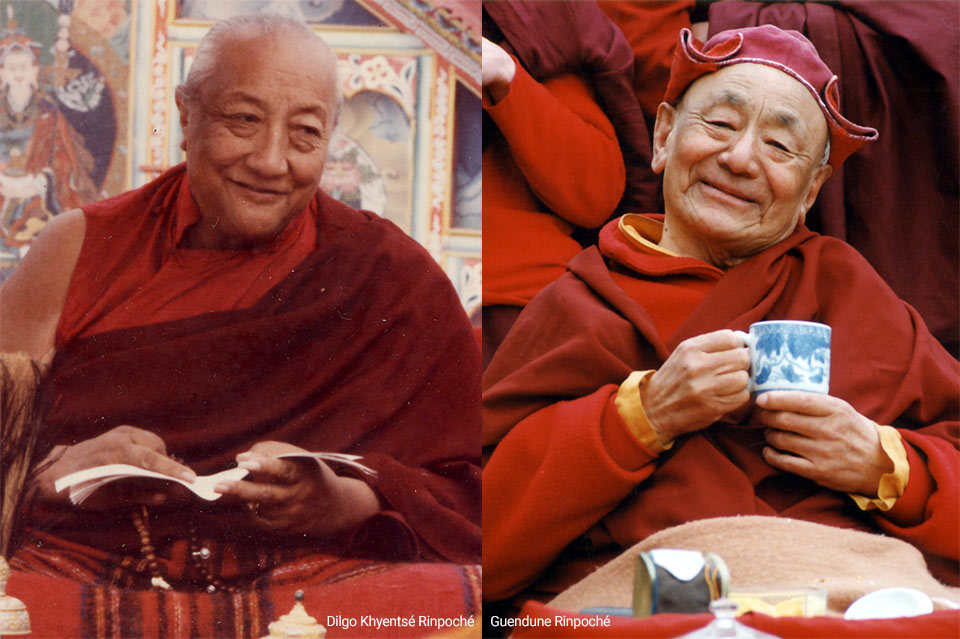Understanding Liberates – Jigme Rinpoche’s December Course
From Study to Application
When we use a mala, the beads come one after another, and each bead looks the same as the one before it. And yet, they are not the same. In addition, there is a string holding the beads together and in order. Jigme Rinpoche’s four annual courses at Dhagpo unfold in the same way. They are not identical, but not really different, with a common thread holding them together: exploring the heart of practicing the Buddha’s teachings. Those who regularly attend these courses feel the thread of an invisible progress in Rinpoche’s instructions, which he seems to repeat from one course to another.
This time, he began by restating the context and pointing out potential pitfalls on the path, as is his habit. Why study? Because if we do not integrate the meaning of the teaching through reflection, our meditation will fall prey to our passing feelings. Furthermore, study gives us appropriate reference points, foundations that allow us to reconsider our way of acting in everyday situations. The goal is to identify what is important and what is not by regularly asking this question: is what I am doing beneficial or not? Once again, karma and causality are a priority. This leads us to the meaning of practice in general: to instill ways of being and acting within us that do not generate suffering. The goal remains to become free from samsara and the functioning that nurtures it. But we do not become free from samsara by rejecting it. The idea is to identify the causes of samsara in order to naturally give them up. The path consists in progressively developing tendencies that disconnect us from confusion and the unhappiness that it creates.
We need to work toward a natural process:
– Suffering is a hardship for all beings.
– There is a possibility of no longer generating suffering.
– What is the source of unhappiness? Our attachments.
– If we free ourselves from attachment, suffering dissipates.
When we understand this process ourselves, from within, then changes in our state of mind can occur and practice yields results. In other words, we cannot force ourselves to become free from attachment. Understanding is what liberates us. By observing the mind and becoming aware of the way our attachment affects us, we make it possible for change to occur naturally.
In addition to the daily teaching session with Rinpoche, the presenters shared their studies of the text Gateway to Knowledge. This time, studying intensifies because, in addition to the chapter on the ayatanas (the description of our process of knowing), there is a second session devoted to revising the aggregates. The meaning of studying becomes clear: first, we receive a precise and detailed message on what we are and how we function.
Then, in meditation and daily observation based on study, we learn how to no longer be overcome by desire and attachment. Nevertheless, this first understanding presupposes an interest in exploring the dharma and getting our feet wet in practice. In other words, we must cultivate the curiosity necessary to face our habits and question them based on the instructions we have received.
Getting to the Heart of Things
To avoid our getting lost in the abundance of teachings we have access to, Rinpoche invites us to keep one crucial point—the fundamental direction—in mind, which allows us not to waste our energy on futile things (those which meet their end sooner or later). The idea is to follow the example of past masters such as Gendun Rinpoche or Dilgo Khyentse, who cultivated values useful to other throughout the entirety of
their lives. In Dharma practice, the things we apply occur within a continuity and with the awareness that actions have consequences. What is the crucial point? To realize Buddha nature, or to realize the dharmakaya.
To do this, undertaking a simple path is the most efficient. Otherwise, the danger of losing ourselves in the complexity, which is a source of difficulty, can lead us to rejecting the path without achieving its goal. A simple path applied correctly yields results. Based on what we have studied, we meditate to get closer to what we are trying to realize. Through meditation, our potential reveals itself and we understand the teachings better.
What does this mean in practice? Studying the teachings is technical in the beginning; they seem like a well-oiled machine that leads in the right direction. Then, as we continue practicing, the key points of study give way to the central point—the heart of things: what we do every day. There is a change in our perception. Things that were unimportant before become crucial and things that seemed paramount lose their importance. This is the result of several ingredients combined: study of the teachings, generating compassion, cultivating meditation, and, thereby, developing solid trust. This process offers a great potential of integration of the dharma in order to actualize the dharmakaya, or the essence of mind—our own wisdom.
These annual course would not have the same feeling without the guided meditation sessions. In our context, meditation allows us to improve our understanding. It contributes to developing our capacities. The goal is for the mind to recognize its own nature and to be able to remain with it free from fabrication. In reality, mind is luminosity and clarity. Luminosity has nothing to do with light; it refers to a non-dual mind endowed with compassion. Clarity refers to a mind unhindered by obscurations. These two aspects are the inherent nature of mind before the appearance of confusion. The goal of meditation is to naturally remain with this primordial state of mind. There is nothing new to acquire. We simply remain with what is. In other words, we can begin by relaxing!
Rinpoche explains how to establish the mind in meditation, by beginning with relaxation and training in non-distraction. The goal is not to restrain the mind but to calm it in order to be able to see what is happening and to identify distraction. In this way, we become more and more aware of what is occurring in our minds. We become habituated to this training. With this foundation, all meditation training—regardless of its form or support—leads to clarity and luminosity. The course concluded with the year and with this relaxation: first with an offering feast for Milarepa in the late afternoon followed by Chenrezig practice to begin the evening. Some participants closed out their year with conviviality and dancing at the annual party organized by some of Dhagpo’s residents. As I am writing this chronicle, 2020 has arrived. Rinpoche reminded us that change is never hard—grasping makes it hard!
Happy New Year to all. May the qualities ever present within each of us naturally reveal themselves.
Puntso, Head of Dhagpo’s Program
Born in 1949, Jigme Rimpoche, received directly from the 16th Karmapa the entirety of the transmissions. After 40 years spent in Europe, Rinpoche has acquired a profound knowledge of Westerners. His teaching and his example inspire practitioners and all who meet him across the world. Today, he is the General Secretary of the 17th Karmapa and the author of numerous works that render Buddhism accessible to all.





